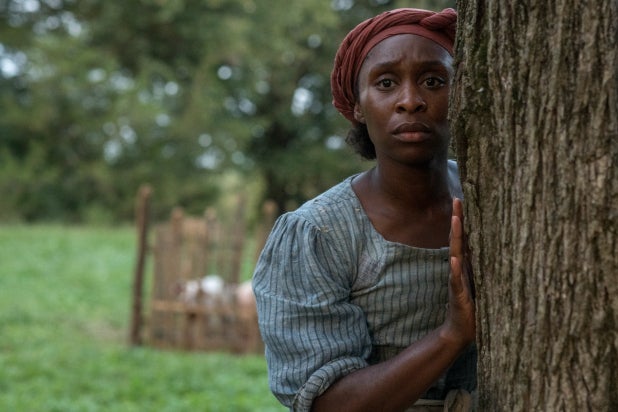We’ve waited too long for a Tubman movie (and for Lemmons to return to the director’s chair) but this one disappoints
Glen Wilson/Focus Features
In life as in art, there are people you root for to do good, to win that prize and get their due recognition. Kasi Lemmons is one of those people. After making the switch from actor to director, she burst onto the screen nearly two decades ago with a wildly unique vision, “Eve’s Bayou.”
Although critics raved and audiences attended, it did not ensure a flourishing filmmaking career the way it might have for a young white male director. Projects stalled or money never came through. She found work, but it’s the gap years on her IMDb profile that neither she nor her audiences will ever get back.
Lemmons’ “Harriet” should have been a heroic return to the world stage. Instead, it’s a disappointingly standard biopic, one whose technical flaws and paint-by-numbers clichés threaten to overshadow its subject’s compelling story.
Watch Video: Watch Cynthia Erivo as Harriet Tubman 'Be Free or Die' in 'Harriet' Trailer
The script by Lemmons and Gregory Allen Howard (“Remember the Titans”) finds a determined young enslaved woman named Minty (Cynthia Erivo, “Widows”) looking for ways to leave with her now-free husband. She’s haunted by the memory of watching her sisters taken and sold away from her family, and the images come to her with alarming frequency. One day, she notices some of those moments in her mind aren’t from that day. They are premonitions to help guide her North, away from an abusive master (Joe Alwyn, “Billy Lynn’s Long Halftime Walk”) and the unhappiness he and his family have brought upon hers.
The 100-mile journey is long and treacherous, but Minty — now renamed Harriet Tubman — cannot live freely until her family does, too. She heads back South to bring them to freedom, taking the first steps to becoming a hero to the hundreds of other slaves she will lead as one of the most famous conductors on the Underground Railroad.
Watch Video: 'Underground' Star Aisha Hinds Says Harriet Tubman Episode Caused 'Anxiety' (Exclusive)
“Harriet” has many of the recognizable signs of an old-school biopic: epic speeches, crowd-pleasing moments, a soaring orchestral score and an unassailable hero. Because it is so rooted in the cinematic language of the past, the film feels like a relic, even though John Toll’s cinematography has a crisp digital look. It’s a visual style not often used for historical dramas, and in the case of “Harriet,” it ends up making the film look more like a made-for-TV movie. There are a few Steadicam shots and CGI-enhanced skies or landscapes that cheapen the movie’s aesthetic, which already look amateurish by distant camera placement and flat compositions.
The audience is set away from the characters, as if we were in a classroom watching a documentary on a rainy day. The ham-fisted dialogue does little to elevate the material beyond an easily digestible good vs. evil narrative. Terence Blanchard’s score often hijacks scenes’ emotions by wringing every possible note of sentimentality. In no way is “Harriet” a subtle movie.
Sadly, there are enough technical flaws in “Harriet” to distract from its powerful story, and Erivo’s performance doesn’t quite save the day either. Many of the scenes feel like first or second takes before Erivo had the chance to figure out her reactions or movement. In one emotional sequence when Harriet is crossing the Pennsylvania border into freedom, there’s an odd half-grin on Erivo’s face that didn’t sit well with the audience at the Toronto Film Festival. They responded by laughing instead of clapping or feeling the emotional weight of what it meant for Harriet to accomplish the impossible.
See Photos: The Scene at Power Women Toronto 2019: Ellen Page, Kasi Lemmons and More
This was not the only time this happened. Fortunately, a number of the supporting cast members, including Janelle Monáe and Leslie Odom Jr., liven up the second half of “Harriet” and bring its lead character down from her mythological hero’s journey back to humanity, where she struggles with their attitudes towards her mission from God.
The memories, dreams and conversations with God end up becoming another stumbling block for “Harriet.” These black-and-white snippets interrupt the movie’s flow and add to the running time without giving much back to the narrative. Although it might be a call back to the premonitions in “Eve’s Bayou,” “Harriet” leans on this device more heavily with less success. Although the movie refers to the trauma and violence inflicted on slaves by their owners, “Harriet” does not go the “12 Years a Slave” route of depicting those horrors. We see only the scars of the past, not how they got there.
Lemmons’ “Harriet” has the distinction of being the first movie about the abolitionist hero. You can feel just how important this project is to her and to the movie’s cast and crew, which is likely why it feels too safe and too stale. Afraid to get things wrong, the filmmakers don’t quite do justice to Tubman’s story. It can’t be easy to be the first to shoulder the responsibility of getting that story right, and it can’t be any easier being one of the few black female directors handed that task.
In any just timeline, it wouldn’t have taken so long to get Harriet Tubman’s legacy on the big screen or for Kasi Lemmons to return to the director’s chair. Hopefully, “Harriet” is not the final word for either of them.
Source: Read Full Article

